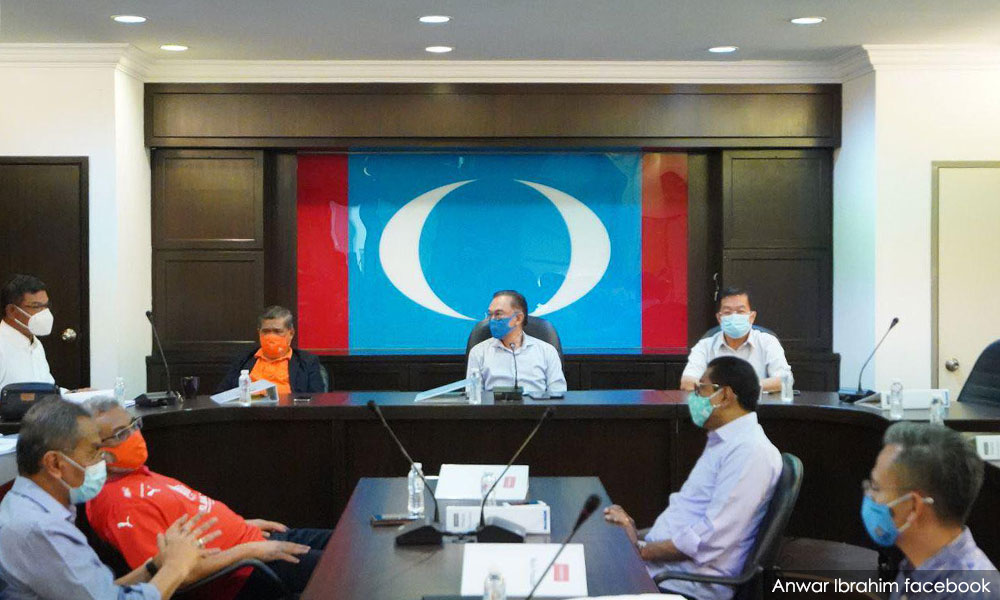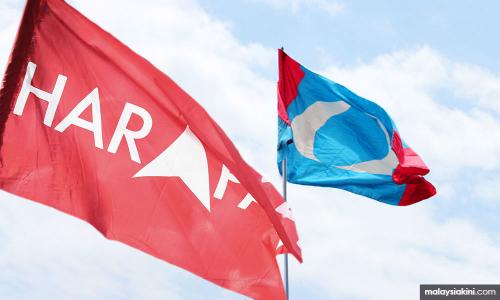MP SPEAKS | PKR or Harapan logo, don’t play checkers in a chess game
MP SPEAKS | PKR has been criticised for breaking rank in using its own logo rather than the Pakatan Harapan logo in the forthcoming Johor state election.
Speaking as an ordinary PKR member, I am of the opinion that it is unfair to label the party’s use of its own logo as breaking away from Harapan or a sign of disunity.
There are valid reasons for PKR to choose its own logo over the Harapan logo.
Giving its best shot
Firstly, uniformity of appearance cannot be more important than allowing a party to give its best shot at winning the election.
In checkers, the pieces move in a uniform pace and direction. Winning is by coordinating and supporting the uniformed movement.
In chess, the pieces do not move in a uniform manner or direction. Winning is by giving the pieces their full range of the board in accordance with their specific and unique movements.
Requiring PKR to use the Harapan logo in the post-GE14 and post-Sheraton Move political environment is moving your pieces like checkers in a chess game.
You are hobbling the full range of the pieces’ movements for the sake of keeping up the mere appearance of uniformity without dealing with the substantive election issues.
Although each component party in Harapan is a multiracial political party, each has its own unique strength and weaknesses:
- PKR is a Malay-majority party
- DAP is a non-Malay majority party
- Amanah is based on Islamic principles
The Harapan Presidential Council made two announcements. First, 20 seats each are to be contested by PKR and Amanah and 16 by DAP. Second, each component party is free to choose either the Harapan logo or their own party logo.

Obviously, the seats were allotted based on the respective party’s specific strengths and capabilities. Certain constituencies were not allotted because the demographics and character of the electorate are not suitable for the party concerned.
This is because not all constituencies are alike. There are urban and rural, non-Malay majority and Malay-majority areas, agricultural and industrial or commercial constituencies.
Each constituency requires different specific strengths and capabilities. To win the seats allotted, the component party must leverage their best resources and attributes suitable for the make-up of the electorate there.
In the continuing struggle to convert voters from electing an ethnonationalist government to a multiracial one, it must be accepted that the day has not come when DAP can win in a Malay-majority rural constituency. It cannot also be denied that there is a resurgence in identity politics post-GE14.
In the circumstances, PKR cannot expect to win in the Malay-majority rural seats holding out a logo that is alleged to represent a DAP-dominant Harapan.
Thus, PKR should not be restricted in displaying its Malay-majority multiracial attributes. This is necessary to counter arguments and the internalised fear that the Malay race will perish without Umno, Bersatu, or PAS.
PKR must be given the latitude to show the full range of its strengths and capabilities to win the Malay-majority areas. This begins by PKR using its own logo.
Learning from failures
Secondly, PKR must be allowed to learn from its failures. In the post-mortem of the Malacca election, it was found that one of the causes for PKR’s disastrous results (there are many causes and weaknesses) is the problems arising from the use of the Harapan logo:
- It must be realised that not every voter is well-informed, especially in rural areas where there is low social media coverage of political developments. The feedback is that some voters thought PKR was not contesting because they could not find its logo on the ballot sheet.
- Due to the SOP restrictions, PKR was not able to successfully counter certain misinformation about the Harapan logo:
- Voters in Malay-majority areas were told the red in the Harapan logo represented DAP’s dominance in the coalition.
- Voters in the non-Malay majority areas were told the red represented Dr Mahathir Mohamad’s return to Harapan.
This situation will be repeated in the Johor election. PKR must therefore use a different strategy to deal with this issue. This is by using its own logo.

Essential political brand
Thirdly, the PKR logo constitutes an essential part of its political brand. In GE14 and previous general elections, voters have a positive brand image and emotional attachment to the PKR logo.
On the other hand, the Harapan logo has a negative brand image and represents negative emotional experiences.
Political scientists, scholars, and marketing experts have found that voters learn about political parties and make voting decisions in the same way they make decisions to buy products or services based on brand recognition and brand loyalty.
The party’s political brand as with the relationship between commercial brands for products or services with its consumers is established and nurtured through long periods of relationship between the party and voters.
Brands are powerful symbols and have a complex system of meaning to the consumers and voters. Brands encompass associations, imagery, self-expressive, and emotional benefits.
The trust that the voters have in the party and “warm feelings” represented by the symbol cannot be established by a one-off transaction as would be the case in using the Harapan logo.
More importantly, the emotional attachment or “brand loyalty” that the voter/customer has for an established brand cannot be transferred immediately to a new brand.
A new logo does not have the same associations in the memory of the voters to activate the motivation to vote for the new logo. According to the scholars’ research, a change of symbol will have an impact on the associative network of the voter’s attachment to the party’s political brand.
This is because it signifies a change in the leadership, party direction, or key policies. The change disrupts the established brand loyalty and brand equity. The change requires the party to rebuild the new brand with the voters which takes time to be accomplished.
A consumer perspective
Gareth Smith and Alan French of the Loughborough University, UK, in an article: “The Political Brand: A Consumer Perspective” explained the concept of the political brand in consumer memory.
Voter/consumer decision-making is based on the cognitive psychology learning theory and in particular the associative network model of consumer memory and the emotional attachment of the consumer to the particular brand;
A brand is designed as a name, term, sign, symbol, or design or a combination of them which is intended to identify the goods or services of one seller or a group of sellers and to differentiate them from those of competitors.
Political parties and by extension their sign, symbol, or logo act as brands to voters just as the brands of products to consumers.
The logo is part of the consumer/voter memory. Voters attach meaning to party names and symbols. For the political brand, the electorate has a high level of recall by their symbols (the elephant, donkey, red rose, and tree) of the political party’s names (Republican, Democrat, New Labour, Conservative) and their policies - conservative, liberal, or labour.
Cognitive psychology learning theory and in particular the associative network model of consumer memory accepts that various associations about a particular object are held in a person’s memory.
Brand knowledge is made from individual pieces of information or nodes. The nodes are linked together in the memory to form a complex associative network about a political party.
The authors gave the example of the information node on the Conservative Party that would link the nodes associated with its leader David Cameron which would link to other nodes on the Conservative Party’s policies.
These may be recalled from memory when a node is stimulated from rest by a process known as activation.
The stimulation is the sight of the party symbol. The type of associations held by voters of the political brand will be the perceived benefits/drawbacks of the brand. Its images stir feelings towards it - experiences of the brand in action held in memory, and accessible when stimulated from the memory of the voter.
Emotional marketing
A customer’s emotional connection to a name, symbol, or design identifies and differentiates a product from other products.
In the article “Emotional Marketing Examples Scientifically Proven To Sway Buyers” examples are given of the emotional attachment to different brands.
Apple is cited as the perfect example of a company that utilises emotions to create a connection with consumers and brand loyalty over time.
Apple’s branding strategy uses simplicity, a clean design, and most importantly a desire to become part of a lifestyle movement. This well-crafted desire appeals to our most basic emotional need: to be part of something bigger than ourselves.
This is one of the reasons why religion and social movements exist, why one is a Democrat or a Republican.
Emotion in politics
In a paper entitled “Emotions in Politics”, scholars reported their research findings that emotional response is a primary supporting mechanism for memory.
All political thinkers agree it is necessary to understand emotion in order to explore human nature and their capacities for politics. Emotion attaches to external events and symbols.
For example, anger at the government arising from a surge of emotion from the imposition of a new tax lead to perceptions of government inefficiency and hostility to “bureaucrats.”
Emotions enable people to steadfastly remain true to their deeply held values and attitudes. On the other hand, emotions are capable of stirring people up, causing them to abandon their habitual commitments.
There is a relationship between emotion and memory, a relationship between emotion and motivation, political judgment and electoral politics, and the neuroscience of emotion.
Researchers who studied symbols have identified the affective component of symbols as the key to persuading and motivating action.
Neuro-imagery scans show that when consumers evaluate brands, they use their emotions, based on personal feelings and experiences, rather than information about the brand, such as features and facts.
Without emotional response, stimuli have no capacity to engage. The power of affective evaluations in predicting the vote is based on people’s emotional reactions to a wide range of political stimuli. This includes the logo.
PKR logo and brand image
Those who voted for PKR have a positive emotional attachment to the PKR logo:
- The PKR logo of the eye has an emotional attachment to its supporters in reminding them of the physical abuse suffered by Anwar Ibrahim and, on reflection, their own sufferings.
- Each voter has his or her own personal association with the party’s cause and struggles. The voter may have suffered from oppression and injustice. He or she may have attended street rallies, protests, and demonstrations or decided to take a political stand with the party.
Those who voted for PKR in GE14 have a negative emotional experience with the Harapan logo. The Harapan logo has come to represent Harapan’s failures:
- Other than Anwar in Port Dickson, Harapan lost five consecutive by-elections using the Harapan logo and recently the Malacca state election.
- The voters’ memory associates the Harapan logo with bad experiences:
- Mahathir not honouring the Harapan election manifesto.
- Mahathir not honouring the agreement to pass the prime minister position to Anwar.
- The defections by Bersatu and the betrayals of PKR MPs in the Sheraton Move causing the collapse of the Harapan government.
- Mahathir resigning as the 7th prime minister with the intention of forming a government without political parties with him as the 8th prime minister.
To many, the Harapan logo is associated with Mahathir. The PKR voters dislike for him generates the same emotions and anger against the coalition if the Harapan logo is used.
The use of the Harapan logo gives rise to voters’ anger or disenchantment that Harapan has not learned from the mistakes made in Mahathir’s 22 months as prime minister.
PKR voters’ emotional attachment to the PKR logo and their emotional indifference to the Harapan logo will be critical in the motivation to vote or abstain from voting for Harapan in the constituencies contested by PKR.
Conclusion
One must remember winners don’t do different things. They do things differently. If PKR wants to win in Johor, it should be allowed to do things differently. Doing things differently is not disunity. Unity does not require uniformity.
In the Bible, Romans 14, it is written that holding different opinions and doing things differently is not disunity. In verse 13, the people are called upon as follows:
"Therefore, let us stop passing judgment on one another. Instead, make up your mind not to put any stumbling block or obstacle in the way of a brother or sister."
I appeal to all parties to remove the stumbling blocks and give PKR the opportunity to give its best shot in the Johor election.
WILLIAM LEONG JEE KEEN is the Selayang MP.
The views expressed here are those of the author/contributor and do not necessarily represent the views of Malaysiakini.
RM12.50 / month
- Unlimited access to award-winning journalism
- Comment and share your opinions on all our articles
- Gift interesting stories to your friends
- Tax deductable
